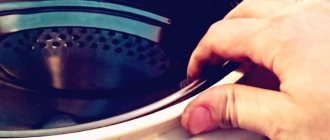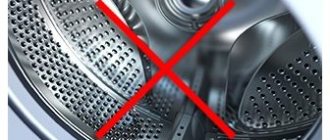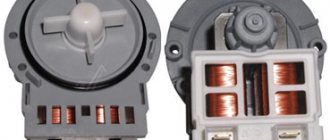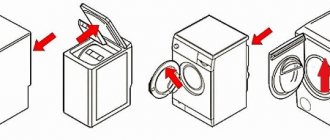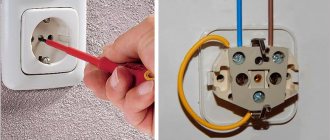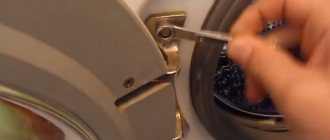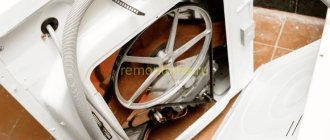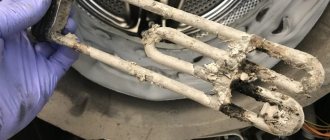- home
- Articles
- Dishwasher won't close
The dishwasher begins its cycle only when the door is locked. This eliminates leaks. There are models with the ability to reload dishes during the process, in which the door does not lock, but for most machines this is a prerequisite. If the door does not close, the appliance does not start the selected washing program. And if it does, this can lead to water and detergent flowing out, causing a leak, and the unit itself will finally fail. There are different reasons why a dishwasher door won't close. They are associated with improper operation, incorrect installation of the device, manufacturing defects or breakdowns that occurred during operation.
Why won't the dishwasher close?
Most often, this problem occurs due to improper installation and use of equipment. If the machine does not close when first started, the cause may be a factory defect. In this case, you must contact the official service center or the seller of the device, since the machine may be under warranty.
If the machine previously worked without problems and suddenly stopped closing, the reasons may be:
- improper placement of dishes or cutlery tray, which prevents the door from closing;
- the sealing rubber around the perimeter of the sash was deformed, which is why it no longer fits tightly to the body;
- the door was warped due to the incorrect position of the machine itself - for some reason it stopped standing straight, and the door changed level and no longer fit tightly;
- the door does not fit tightly not at the lock location, but around the perimeter due to the fact that the cable of the closing mechanism has broken or the spring in this device has stretched;
- The lock or electronic control module is broken.
If any of the above problems occur, the machine cannot be operated.
How to do DIY repairs
If you cannot close your new Bosch, Hotpoint Ariston or other machine, contact the service center immediately. But if the equipment has been in use for a long time, then start by checking the lock.
Lock installation
Before drawing water, the dishwasher locks the door not only mechanically, but also electronically. A characteristic click indicates that the lock has been activated. The control module blocks closing by sending an impulse to the lock. Therefore, it is not possible to open the chamber during the wash cycle.
The exception is PMM models with a reloading function. When you press the key, the water flow stops and the hopper opens. After loading the devices, the door is locked again.
Sequence of work:
- If you notice that the lock is deformed, open the door.
- Unscrew the screws around the perimeter of the front panel.
- While holding it, remove the cover. Behind it you will find a lock and wires leading to it.
- Note or photograph the location of the wiring.
- Disconnect the wire plugs.
- Remove the two screws at the top that secure the lock.
- To replace, you will need a repair kit, which can be purchased at the store.
- Place the new element in place and attach the wiring.
- Replace the cover and secure the fasteners.
When the fastening “antennae” of the lock is damaged, you can repair it yourself.
Use a file to sharpen any sharp edges that have broken off. Take a tin plate 0.5 mm thick, 4 mm wide. Bend it along the edges and make holes for fastening (as in the photo):
Also prepare holes on the sides of the lock. They should match those on the plate. Attach the plate to the lock with self-tapping screws. Assemble the mechanism.
What to do if your dishwasher door won't close
If the cause of the problem is the incorrect placement of dishes and cutlery inside the hopper, you need to rearrange them so that they do not interfere with closing. Also check whether the rollers on which the trays move have come out of the guides. Their incorrect position also becomes an obstacle to closing the door.
If the dishwasher door does not close tightly, check the position of the unit itself with a level. If it is at an angle, straighten it out. The door should take the correct position and close. Check that the machine rests on all four feet. You may need to unscrew some or all of them to get them level. Visually, the machine may stand level, but during operation it vibrates, which gradually causes displacement.
Inspect the rubber seal on the cover. From prolonged use, too hard water, or unsuitable detergents, it could crack, swell, stretch, or, conversely, shrink. If the cuff is deformed, it needs to be replaced. You can do this yourself if you buy suitable rubber at a hardware store. It is better to buy a cuff designed for your brand of car. Universal ones are also available, but they may not be suitable. The seal is simply inserted into the groove instead of the old one. If necessary, it can be trimmed.
You can also try replacing a self-stretched spring or a broken cable in the lid closing mechanism, if they are the cause of the malfunction. These parts are sold in stores or service centers. If the dishwasher model allows you to perform such minor repairs without disassembling its body, you can do it yourself. If not, it is better to call a specialist.
Attention: all repair work must be carried out strictly with the equipment turned off from the network!
Preparation for work
Before adjusting the door, it is worth preparing in advance. Proceed like this:
- disconnect the equipment from the network;
- remove the built-in device from the niche;
- disconnect communications - water inlet and drain hoses;
- prepare a set of tools - anything you have in your home workshop will do;
- Please read the instructions below to describe the progress of the work before setting up the machine yourself.
How to disconnect PMM from communications? It's simple:
- Disconnect the machine (Bosch, Kandy or another brand) from the electricity. Roll up the power cord and hang it on the mount pre-designed by the designers.
- Turn off the water supply valve to the dishwasher.
- Disconnect the water intake hose.
- Now you can begin to disconnect the drain hose - do not forget to install a plug at its end.
- Find the fasteners that secure the body of the machine in the niche of the furniture set.
- Arm yourself with a Phillips (plus) screwdriver and unscrew the screws that secure the case.
- Take the equipment out of the closet. The machine rarely weighs more than 40-50 kg, so you can handle it alone, but you should still act carefully.
- Cover the floor before installing equipment on it. Provide full access to the machine from all sides.
What tools do you need next? Stock up:
- Phillips screwdriver;
- hexagon;
- pliers;
- metal cable 1.5 mm.
You may not need the latter, so hold off on purchasing it until you're sure you really need it.
If the lock is broken
When the machine's lid does not close, the cause may be a mechanical failure of the lock or lock. Older models have plastic lock parts that break easily. In most cases, a broken lock cannot be repaired, but you can replace it with a new one. The main thing is to choose the same one that was installed in the dishwasher. You can do this yourself or call a dishwasher repairman to your home. He will remove the old lock, install a new one and check its operation. To do this, you do not need to dismantle the entire device and take it to a workshop; everything can be done at home.
Another reason why the door does not close tightly and the washing process does not start is the failure of the triac responsible for blocking the door. The control unit simply does not understand that the door is closed, so it does not give a command to supply water and start the program. In this case, you will not be able to repair the machine yourself. You'll have to call a specialist.
Malfunctions
If you have been using the machine for a long time and the door was fixed normally, but suddenly stopped holding, it is most likely a breakdown. Here are the malfunctions in which the PMM does not fix the door and it falls down.
Mechanical damage to the door lifting mechanism - from RUB 1,400.
Due to long-term use, door closers, cables (rope ones especially often fray), and plastic holders may fail. Sometimes it pulls the spring out of the pan body.
Signs
The PMM door does not lock open and falls.
How to fix
The door lift mechanism needs to be repaired. Parts that fail must be replaced (a repair kit for the door is used).
Damage to the door hinge - from RUB 1,200.
If the PMM is handled carelessly - abruptly opening the door, children “riding” on it - the hinges bend or the hinge mechanism breaks.
Signs
The dishwasher door does not lock well in the open position and does not close well. Skew may be noticeable.
How to fix
Repair of hinges is required if possible (for example, when there is minor deformation or when the hinge axis has come out). In case of serious damage, the loop is replaced with a new one.
Dishwasher repair from Top-Refit
Whatever the reason why the door won’t close, repairmen from Top Refit can solve the problem at home. Call us, name the brand and model of the device, describe the symptoms of the malfunction, and we will send a specialist to you at a convenient time with the necessary tools and parts. Our craftsmen work quickly, carefully, without damaging the environment. Repairs, replacement of components and configuration in this case are inexpensive. They do not require much time, but they extend the life of the equipment by several years.
Preparatory activities
Experts recommend that before attaching the facade panel, preparatory work is carried out, during which the necessary materials and tools are prepared.
Tool
To perform installation work, you will need special working tools, among which are the following:
- Screwdrivers. These are common tools that are found in almost every home. Most often they are used if it is necessary to screw in screws and screws. Screwdrivers may differ in purpose and size. The choice of suitable models depends on the type of fastenings used.
- Roulette. When carrying out installation work, it is necessary to take various measurements. For this, a tape measure is used, with which you can take measurements.
- Screwdriver. This is a hand-held electric tool that is often used for driving and unscrewing self-tapping screws, screws and screws. You can also use it to drill holes into which fasteners will be installed in the future.
- Marker or pencil. They will be needed to mark the places where the mounting holes will be drilled.
- Awl. This tool is used if you need to pierce holes in fragile surfaces. It is recommended to use a strong awl to prevent it from breaking during the piercing process.
Materials
To install the facade you will not need as many materials as tools. Among the most important materials are:
- Stencil. This is a very important detail that can help when installing the facade. With its help, the places where the mounting screws will be installed are marked. To use a stencil, you need to attach it to the panel and mark the places for fastenings.
- Scotch. For installation work, it is recommended to use double-sided tape. You will need it to attach the façade to the surface before screwing in the screws.
Doesn't wash well
Sometimes, after some time after you start using it, you notice that the dishwasher does not wash dishes as well. Such malfunctions are usually associated with violation of operating rules, but there may also be technical problems. So, what could be the reasons that the quality of washing dishes has deteriorated:
- Insufficient amount of detergent (occurs after purchasing a new detergent).
- The dishes are not stacked correctly.
- The heating element has burned out, the water is not heating up.
- The filter-sump is clogged (the process is described above). We troubleshoot dishwashers: cleaning the drain and water injection holes is never a bad idea
- The impellers - the holes for spraying water - are clogged. They are overgrown with salts and clogged with residues. Needs cleaning periodically.
- The pressure tap chamber is clogged. It is located next to the drain hole. We unscrew the bolt, pull it out, and wash it. We clean the holes into which it is inserted.
Dishwasher malfunctions due to deterioration in quality can also be caused by control failures. If you have checked all possible causes and there is no improvement, follow the process. You may be able to figure out why your dishwasher has gotten worse at cleaning dishes.
